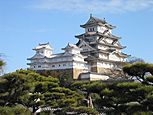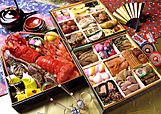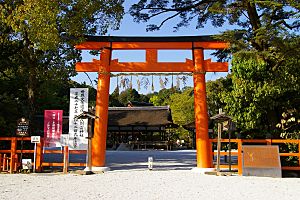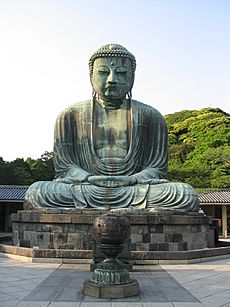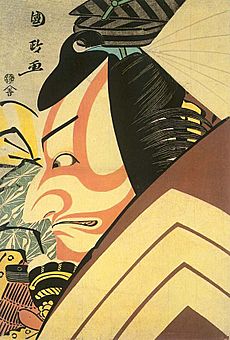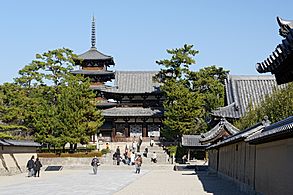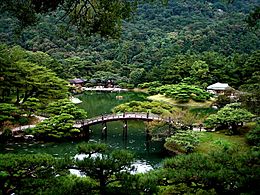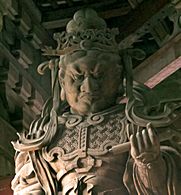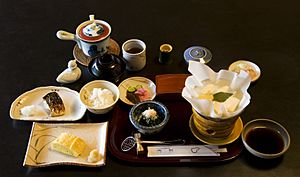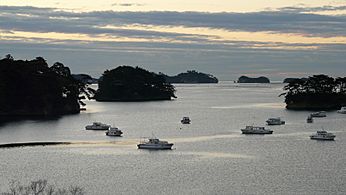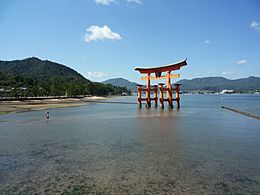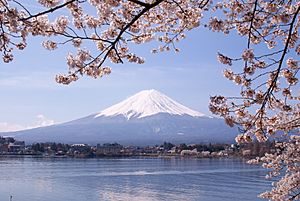Culture of Japan facts for kids
The culture of Japan is very old and has changed a lot over thousands of years. It started way back in the Jōmon period (prehistoric times). Today, Japanese culture is modern and takes ideas from all over Asia and the rest of the world.
Japan's culture has become one of the most important cultures globally. This is mostly because of its popular culture, like anime and video games. In 2021, Japan was ranked as having the highest cultural influence in Asia and 5th worldwide.
Contents
- How did Japanese culture begin?
- What language do people speak in Japan?
- What are the main religions in Japan?
- What is Japanese literature like?
- What are Japanese visual arts?
- What is traditional Japanese clothing?
- What are Japanese buildings and gardens like?
- What is Japanese music like?
- What are Japanese performing arts?
- What sports and hobbies are popular in Japan?
- What is Japanese food like?
- What is Japanese popular culture?
- What are Japan's cultural landscapes?
- What are Japan's national symbols?
- Images for kids
- See also
How did Japanese culture begin?
Scientists have a few ideas about where the Japanese people came from.
One idea is that modern Japanese people are a mix of two groups. The first group was the original people of Japan, called the Jōmon people. The second group arrived later from East Asia, called the Yayoi people. The Yayoi people brought new ideas, like growing rice, between 1000 BCE and 300 CE. They mixed with the Jōmon people, and this created Japan's early culture. Today, most Japanese people have about 80% Yayoi and 20% Jōmon ancestors.
Another idea suggests three main groups. These are the Jōmon, Yayoi, and a third group from the Kofun period. During the Kofun period, people from China came to Japan. They brought new cultural ideas and ways to lead a country. These Kofun migrants were similar to the Han Chinese people. The Jōmon people were hunter-gathers. The Yayoi people taught rice farming. And the Kofun migrants helped create a strong government.
For a long time, Japanese culture was greatly influenced by different Chinese dynasties. The Tang dynasty in China had a big impact. For example, one way to write Japanese uses Chinese characters, called kanji. Even though Japanese doesn't come from Chinese, it uses many of its characters. Later, starting in the Meiji era, Japan began to be influenced more by Western countries.
Japan was mostly closed off from the rest of the world for over 220 years. This was during the Tokugawa shogunate. This period of isolation ended when American ships, called the "Black Ships", arrived.
What language do people speak in Japan?
Japanese is the main language spoken in Japan. It has a special way of using high and low sounds in words, called a pitch-accent system. We know a lot about early Japanese from writings made in the 8th century. The oldest record of the Japanese language is from a Chinese document in 256 CE.
Japanese is written using three different systems: kanji, hiragana, and katakana.
- Chinese characters, called kanji (漢字), are used a lot in Japanese writing. They are like pictures that stand for whole words or ideas. They came from China around 50 CE, before Japan had its own writing system.
- Today, many kanji in Japanese have a different meaning than the same characters in Chinese. Japanese people use fewer kanji overall. They mainly use them for nouns, parts of adjectives, and parts of verbs.
- Both hiragana and katakana are phonetic systems. This means each symbol stands for a sound, like our alphabet. They were created from simpler kanji. Hiragana appeared around the 9th century and was first used mostly by women for informal writing. Katakana was mainly used by men for formal writing. By the 10th century, everyone used both.
Japanese words come from different places. About 49% are from Chinese. About 33% are original Japanese words. And 18% are words borrowed from other languages, especially European ones.
The Latin alphabet (like the one we use) is also used in modern Japanese. You'll see it in company names, logos, and ads. It's also used when typing Japanese on a computer. For numbers, people usually use the numbers we know (1, 2, 3). But traditional Japanese numbers are also common.
Japanese culture has influenced the Western world a lot. Many Japanese words are now part of the English language. Words like origami (paper folding), tsunami (giant wave), and karaoke (singing with music) are examples. Pop culture words like shonen and shōjo (types of manga/anime) are also used. Many of these words are even in the Oxford English Dictionary.
What are the main religions in Japan?

The two main religions in Japan are Shinto and Buddhism. Many Japanese people practice both.
Shinto
Shinto is a very old Japanese religion. It focuses on ceremonies and rituals. Shinto followers believe that kami (Shinto gods or spirits) are everywhere in nature. You can find them in rocks, trees, and mountains. People can also have a kami spirit. A main goal of Shinto is to keep a strong connection between humans, nature, and kami. This religion started in Japan before the 6th century CE. Later, people built shrines to worship the kami.
Buddhism
Buddhism started in India a long time ago. It then spread through China and Korea before reaching Japan in the 6th century CE. At first, it wasn't very popular because its ideas were hard to understand. But people loved the art that came with Buddhism, which helped it become more popular.
Buddhism teaches about the cycle of rebirth and karma. In Buddhism, what you do (good or bad deeds) is more important than your social status. Everyone gets sick, grows old, dies, and is reborn into a new life. This cycle is called saṃsāra. The goal of Buddhism is to escape this cycle by gaining true understanding.
Christianity
Christianity came to Japan in the 16th century. Later, it was banned in the 17th century. During this time, a group of hidden Christians secretly practiced their faith. They mixed Christian ideas with Shinto and Buddhist traditions. Their special Christian art and hidden sites in the Nagasaki Region are now World Heritage Sites.
Even though Christianity is a small religion in Japan, Christian chapel weddings are a very popular choice for Japanese couples.
What is Japanese literature like?
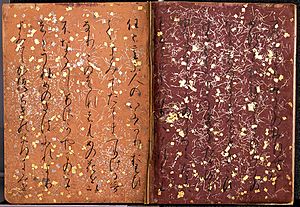
Early Japanese literature was greatly influenced by China. Many early works were even written in Classical Chinese. But over time, Japanese writers started creating their own unique style. They wrote about Japan and its people. The Tale of Genji, written by Murasaki Shikibu during the Heian period, is a famous example of unique Japanese literature known worldwide.
Since Japan opened up to Western countries in the 19th century, Eastern and Western literature have influenced each other a lot. This continues even today.
What are Japanese visual arts?
Japanese calligraphy is a traditional art form. It uses flowing brush strokes to create beautiful writing. Calligraphy works can be phrases, poems, stories, or even single characters. The way the writing looks can show the meaning of the words. For example, the texture or speed of the brush strokes can add to the art. There are many styles of Japanese calligraphy. Artists put a lot of effort into each piece. Sometimes, it takes over a hundred tries to get one perfect character! This art is called shodō (書道), meaning 'the way of writing'.
Painting has been an art in Japan for a very long time. The brush is a traditional tool for both writing and painting. Japanese painters often focused on specific subjects, like animals, landscapes, or people. Chinese papermaking came to Japan around the 7th century. Later, washi (Japanese paper) was developed. Japanese painting still uses its own traditional methods, as well as ideas from Asia and the West. Famous Japanese painters include Kanō Sanraku and Maruyama Ōkyo.
Ukiyo-e means 'pictures of the floating world'. This is a type of woodblock print that shows what Japanese art was like before the Meiji era. These prints could be made in large numbers. So, many people in Japan could buy them, even if they weren't rich. Ukiyo-e was very popular from the 17th to the 20th century.
Japanese lacquerware and ceramics are also very famous around the world. Lacquerware has been sold to other countries since the Muromachi period. Ceramics have been exported since the Edo period.
Ikebana is the Japanese art of arranging flowers. It is known worldwide for its focus on balance, color, rhythm, and simple, elegant designs. It's an art that often shows the seasons and means something deeper than just the flowers themselves.
What is traditional Japanese clothing?
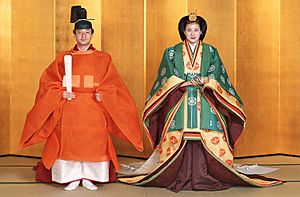
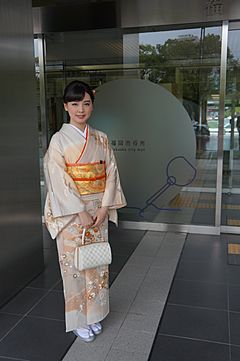
The kimono is the national clothing of Japan. It developed from Chinese court clothes during the Nara period. The word kimono means 'thing to wear on the shoulders'. Before the Edo period, most kimono-like clothes were called kosode (short sleeve). Longer-sleeved ones were called furisode (swinging sleeve).
The first kimonos were very similar to traditional Chinese clothing, called hanfu. This influence came from Japanese trips to China. By the 8th century, Chinese styles were very popular. After Japan stopped sending envoys to China, these styles changed on their own. The overlapping, V-shaped collar became a unique Japanese fashion.
Kimono and other traditional Japanese clothes are called wafuku, meaning 'Japanese clothing'. This is different from yofuku, which means Western-style clothing. Kimonos come in many colors, styles, and sizes. Men usually wear darker or softer colors. Women tend to wear brighter colors and pastels. Younger women often wear kimonos with fancy patterns of flowers or abstract designs.
The happi coat is another type of traditional clothing. A happi coat has straight sleeves. It is usually decorated with a family symbol or kanji on the collar. In the past, firefighters wore happi-style coats. These coats were made of many layers of thick cotton. They would soak them in water to protect themselves from fire.
Japan also has special footwear. tabi are ankle-length socks with a split toe. They are worn with kimonos and traditional shoes like geta and zōri. Geta are sandals with wooden blocks under the sole. Both men and women wear them with kimonos or yukata. Zōri are flat or slightly sloped sandals made from different materials. They are considered more formal than geta.
What are Japanese buildings and gardens like?
Japanese architecture was first heavily influenced by Chinese architecture. But later, it developed many unique Japanese features. You can see examples of traditional buildings at temples, Shinto shrines, and castles in Kyoto and Nara. Some of these buildings have beautiful traditional gardens. These gardens are often influenced by Zen ideas. Modern Japanese architects sometimes mix traditional Japanese and Western styles.
Traditional Japanese gardens are as important as the buildings themselves. They share similar historical and religious backgrounds. A key idea in garden design is to create a landscape that looks like a three-dimensional ink painting. This type of painting is called sumi-e or suibokuga. So, designing gardens is considered a high art form in Japan.
Traditional Japanese sculptures mostly show Buddhist figures. These include Tathagata, Bodhisattva, and Myō-ō. The oldest sculpture in Japan is a wooden statue of Amitābha at the Zenkō-ji temple. During the Nara period, the government ordered many Buddhist statues to show its power. You can see these today in Nara and Kyoto. A famous example is the huge bronze Buddha statue in the Tōdai-ji temple.
Wood is the main material used in Japanese sculpture, just like in traditional architecture. Statues are often lacquered, gilded (covered in gold), or brightly painted. Bronze and other metals are not usually used. Other materials like stone and pottery have also been very important in traditional sculpture.
- Installation arts
-
Hōryū-ji is widely known to be the oldest wooden architecture existing in the world.
-
Guardian in Tōdai-ji, Nara
What is Japanese music like?
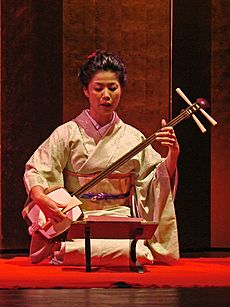
Japanese music includes many different styles, both traditional and modern. The Japanese word for music is ongaku (音楽). It combines the kanji for "sound" (音) and "enjoyment" (楽). Japan has the second largest music market in the world, after the United States. Most of the music sold in Japan is by Japanese artists.
Traditional Japanese music is quite different from Western music. It is based on the rhythm of human breathing, not strict mathematical timing. Traditional music also often slides between notes, which is not common in Western music.
What are Japanese performing arts?

Japan has four main traditional types of theater: noh (or nō), kyōgen, kabuki, and bunraku.
- Noh theater started from a mix of music and dance. It uses special masks, costumes, and very controlled movements. Actors sometimes use a fan to represent other objects.
- Kyōgen plays are funny. They came from entertainment brought from China in the 8th century. Masks are rarely used in kyōgen.
- Kabuki theater began in the early Edo period with dances performed by Izumo no Okuni in Kyoto. The government banned women from performing in 1629. After that, only men played female roles (onnagata). Kabuki also uses special makeup for actors in historical plays.
- Japanese puppet theater, called bunraku, developed around the same time as kabuki. It has an even older history, starting in the Heian period.
What sports and hobbies are popular in Japan?

During the long time when the samurai class ruled Japan, they developed many ways to train warriors. These became well-organized martial arts, known as koryū. Examples include kenjutsu, kendo, kyūdō, sōjutsu, jujutsu, and sumo. These were all created during the Edo period. After big changes in Japan during the Meiji Restoration, some martial arts became modern sports, called gendai budō. Judo was developed by Kanō Jigorō from different types of jujutsu. These sports are still widely practiced in Japan and other countries today.
Baseball, soccer, and other popular Western sports came to Japan during the Meiji period. These sports are commonly played in schools, along with traditional martial arts. Baseball, soccer, and ping pong are among the most popular sports in Japan. Soccer became very popular after the J League (Japan Professional Football League) started in 1991. Japan also helped host the 2002 FIFA World Cup. Many companies also sponsor semi-professional teams for sports like volleyball, basketball, rugby union, and table tennis.
What is Japanese food like?
Over a long history, the Japanese have created very special and delicious food. In recent years, Japanese food has become very popular in the United States, Europe, and many other places. Dishes like sushi, tempura, noodles, and teriyaki are well-known. The Japanese diet mainly includes rice, fresh seafood, and pickled or boiled vegetables. Many people believe that the Japanese diet helps people live a long time.
What is Japanese popular culture?
Japanese popular culture shows what people think and care about today. But it also connects to the past. Popular films, TV shows, manga (comics), music, anime (animation), and video games all grew from older art and literature. Many of their themes and styles come from traditional art forms. Modern popular culture, like traditional art, offers entertainment and a way to escape from the busy industrial world. Many anime and manga are famous worldwide and keep growing in popularity. Japanese video games, fashion, and game shows are also very popular.
In the late 1980s, families often spent their free time together, like going to parks or shopping. Even though Japan is known for hard work, Japanese people look for fun wherever they can find it. You often see Japanese commuters on the train reading their favorite manga or listening to music. There's a huge variety of entertainment available. This includes a lot of music, films, and products from the big manga and anime industries. Game centers, bowling alleys, and karaoke are popular places for teens to hang out. Older people might play shogi (Japanese chess) or go in special parlors. Together, the publishing, film/video, music/audio, and game industries make up Japan's growing content industry.
What are Japan's cultural landscapes?
Japan has 51 official cultural landscapes (文化的景観, bunkateki keikan). These are places that show how people lived and how the land shaped their culture. They are important for understanding the lifestyle of the Japanese people.
The Three Views of Japan (日本三景, Nihon Sankei) is a famous list of Japan's three most beautiful sights. This list was made by a scholar in 1643. They are:
- The pine-covered islands of Matsushima in Miyagi Prefecture.
- The pine-covered sandbar of Amanohashidate in Kyoto Prefecture.
- Itsukushima Shrine in Hiroshima Prefecture.
- Three Views of Japan
-
Torii at Itsukushima Shrine
What are Japan's national symbols?
Japan is an island country located east of Asia. It is seen as the most eastern Asian country because the huge Pacific Ocean is to its east. This means the sun rises in Japan before it reaches the Asian continent. The Japanese characters for the name of Japan literally mean 'sun origin'. It is pronounced 'Nihon' or 'Nippon'. This is why Japan is often called "Land of the Rising Sun".
The Nisshōki (日章旗, "sun-rise flag") is the national flag of Japan. It shows the rising sun and matches Japan's name. The earliest records of this flag are from the 7th century CE. In 607, a letter was sent to the Chinese Emperor that started with "from the Emperor of the rising sun". This shows how important the sun is in Japanese culture.
The Sun is also very important in Japanese mythology and religion. The emperor is believed to be a direct descendant of the Sun goddess Amaterasu. She is the goddess of the Sun and the universe in the Shinto religion. The emperor is seen as "the symbol of the State and of the unity of the people." Emperor Jimmu (神武天皇, Jinmu-tennō) is considered the first emperor and founder of Japan.
Japan's national animals are the green pheasant, koi fish, and the great purple emperor butterfly. The Imperial Seal of Japan is a special symbol used by the Emperor and the Imperial Family. The cherry blossom (Prunus serrulata) and chrysanthemum morifolium are the unofficial national flowers of Japan. Japan's unofficial national dishes are sushi, Japanese curry, and ramen. The unofficial national drink is sake.
Mount Fuji (富士山, Fujisan) is the national mountain of Japan. It is one of Japan's "Three Holy Mountains" (三霊山, Sanreizan). It is also a very beautiful and historic site. The top of the mountain has been considered a sacred place since ancient times. As a national symbol, Mount Fuji has appeared in many artworks and media. These include paintings, woodblock prints (like the Thirty-six Views of Mount Fuji), poems, music, theater, films, manga, anime, and pottery.
Images for kids
-
Left panel of the Shōrin-zu byōbu, by Hasegawa Tohaku, c. 1595, six-fold screen, ink on paper, National Treasure
-
Fūjin-raijin-zu by Tawaraya Sōtatsu, with Raijin shown on the left and Fūjin right, 17th century
-
Traditional Japanese ceremony at Itsukushima Shrine
-
Lolita fashion is a fashion subculture that is highly influenced by Victorian and Edwardian from the Rococo period.
See also
 In Spanish: Cultura de Japón para niños
In Spanish: Cultura de Japón para niños
- Cool Japan
- History of Japan
- Marriage in Japan
- National symbols of Japan
- List of World Heritage Sites in Japan
- Imperial House of Japan
- Tourism in Japan
- Japanese language
- Etiquette in Japan
- Religion in Japan
- Japanese cuisine
- Japanese aesthetics
- Japanese music
- Japanese performing arts
- Science and technology in Japan
- Japanese martial arts
- Japanese influence on Korean culture
- Korean influence on Japanese culture
- Chinese influence on Japanese culture
- Yamato damashii



